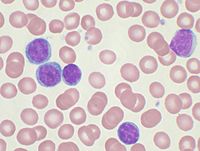
Photo from wikipedia
INTRODUCTION The aims were to evaluate quality of life, cosmetic results and surgical outcomes of robotic single-site and robotic multiport total laparoscopic hysterectomy with sentinel lymph node mapping in women… Click to show full abstract
INTRODUCTION The aims were to evaluate quality of life, cosmetic results and surgical outcomes of robotic single-site and robotic multiport total laparoscopic hysterectomy with sentinel lymph node mapping in women treated for low- risk endometrial cancer. MATERIAL AND METHODS The study is a prospective, multicenter, case-control study conducted at Ospedale Santa Chiara in Trento and Novara and Pavia University Hospitals. 76 consecutive patients with a biopsy-confirmed diagnosis of low-risk endometrial cancer or atypical endometrial hyperplasia who had undergone robotic total laparoscopic hysterectomy and sentinel lymph node mapping were included between January 2017 and January 2019. Data on surgical outcomes, quality of life and cosmetic results were prospectively collected and analyzed based on the surgical approach with robotic single-site vs robotic multiport assistance. Patients' clinical characteristics, intraoperative parameters, sentinel lymph node mapping results and postoperative findings were prospectively recorded. Clinical follow-up was performed 4 weeks and 6 and 12 months after surgery. 51 patients underwent a robotic multiport procedure and 25 patients robotic single-site surgery. RESULTS There was one significant difference between the two groups in terms of patient characteristics: mean BMI in the multiport group was 29 Kg/m2 , vs 24.8 kg/m2 in the single-site group (p-value <0.001). After univariate and multivariate analysis on intraoperative and postoperative findings, a shorter surgical time was observed in the single-site cohort than in the multiport group (148.7 vs 158.2 minutes, p-value 0.0182). BMI also had a significant effect on surgical time (p=0.022). No differences were seen in terms of sentinel lymph node detection: the bilateral detection rate was 96.1% for multiport (66.7% bilateral, 29.4% monolateral) and 96% for single-site (76% bilateral, 20% monolateral) procedures. No differences between the two approaches were identified with regard to postoperative complications, pain, cosmetic results and quality of life comparisons. CONCLUSIONS For the treatment of low-risk endometrial cancer and atypical endometrial hyperplasia with total hysterectomy and sentinel lymph node mapping, the robotic single-port approach is comparable with the multiport procedure in terms of intraoperative and postoperative findings, and has an advantage in terms of shorter surgical times. Further studies are required to identify possible differences in quality of life and cosmetic results.
Journal Title: Acta obstetricia et gynecologica Scandinavica
Year Published: 2020
Link to full text (if available)
Share on Social Media: Sign Up to like & get
recommendations!